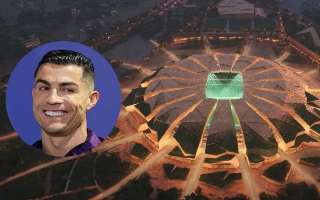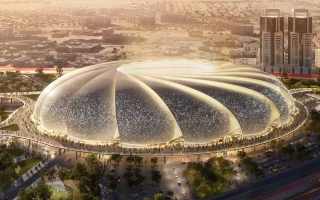King Fahd Sports City
| Capacity | 70 000 |
|---|---|
| Country | Saudi Arabia |
| City | Riyadh |
| Clubs | – |
| Category | Design being implemented |
| Cost | ? |
| Construction | 2024–2026 |
Advertisement
King Fahd Sports City – design description
What is the King Fahd Sports City redevelopment project in a nutshell?
The project to modernize King Fahd Sports City, so far the largest and most important stadium in the country, primarily involves removing the athletics track and bringing the stands closer to the pitch, giving the facility a football-specific character.
The reconstruction of the stands will be very significant – only the upper floor of the eastern stand and a small central section in the west will be retained from the existing structure.
The roof membrane will also be dismantled, but will later be recreated in the same characteristic form and enriched with an additional internal section with a panoramic screen.
The plans to rebuild the stadium were conceived when Saudi Arabia bid to host the 2027 Asian Cup, but they took on additional significance in October 2023 when the country secured the right to host the 2034 World Cup.
Construction work began in late 2024 and is expected to last until 2026.
How did the King Fahd Sports City redevelopment project come about?
What does King Fahd Sports City look like?
King Fahd Sports City opened in 1987 and is the largest stadium in Saudi Arabia. The facility has witnessed many significant events, including Confederations Cup, World Youth Championship, national team games and matches of the local clubs. Although the stadium has an athletics track, it is much more often used for football than for athletics events.
The facility is distinguished by its unique membrane roof, reminiscent of Bedouin tents. At the time of its opening, it was the largest stadium roof in the world in terms of area (47,000 m²).
When were the first plans to modernize King Fahd Sports City made?
Plans to modernize the country's most important stadium had been in the works for some time. In 2016, a concept by the Italian studio Schiattarella Associati was adopted, which involved expanding the facilities and making some changes to the stands, while preserving the stadium's image and its distinctive roof.
The Italian architects' design was ultimately not implemented, and the stadium remained unchanged since its opening. However, with Saudi Arabia's growing ambitions to host major sporting events, especially in football, further plans to modernize the facility began to be developed.
When was the current concept for the redevelopment of King Fahd Sports City created?
Saudi Arabia wanted to create a joint bid with Greece and Egypt to host the 2030 World Cup, and the country also applied to host the 2027 Asian Cup.
The joint bid for the World Cup did not work out, but on February 1, 2023, Saudi Arabia was confirmed as the host of the 2027 Asian Cup. On the same day, plans for the stadiums for the event were presented to the wider public, including the redevelopment of King Fahd Stadium, which was to play a key role and host, among others, the final of the tournament.
The main idea behind the project was to remove the athletics track and convert the stadium into a football-specific venue.
Will King Fahd Sports City be the venue for the World Cup?
Although it failed to compete for the 2030 World Cup, Saudi Arabia, this time on its own, decided to bid for the next edition of the World Cup, to be held in 2034. In October 2023, FIFA was accepting applications from candidates. The process was limited to countries from Asia and Oceania, and since Saudi Arabia was the only one to submit a bid, it practically secured the right to host the tournament.
In preparation for the World Cup, Saudi Arabia had to present an even more ambitious bid than for the Asian Cup. The full list of 15 venues proposed for the tournament was announced on July 31, 2024, when the so-called “bid book” was published.
The list of stadiums for the World Cup naturally included King Fahd Sports City, although no longer as the largest and most important venue, as the huge King Salman International Stadium is to be built to host the opening and final matches, as well as serving as the new national stadium.
What changes have been made to the King Fahd Sports City redevelopment project?
In December 2023, an updated concept for the stadium's reconstruction was presented, which introduced, among other things, a slightly different appearance of the stands and a smaller capacity (70,000 spectators, compared to the previously announced 80,000), as well as a changed arrangement of the surroundings.
A little earlier, in November 2023, another change took place. The stadium's previous name, King Fahd International Stadium, was replaced with a new one: King Fahd Sports City.
What does the King Fahd Sports City redevelopment project entail?
The project involves the removal of the athletics track and the reconstruction of the stands, which will be redesigned for football and moved closer to the pitch. Thanks to the expansion, the stadium's capacity will increase to approximately 70,000 spectators.
The reconstruction of the stands will be quite significant – only the upper floor of the eastern stand and a small central section in the west, with a luxurious VIP area and a royal box, will be retained from the existing structure. The work will also include lowering the pitch.
During the reconstruction, the huge roof membrane will be removed, although it will later be recreated in the same form and enriched with an additional internal section covering the lowest rows as well as a panoramic screen attached to the edge.
As part of the modernization, a sports museum and new shops will be built at the stadium. Changes will also take place in the venue's surroundings.
Despite the removal of the athletics track, it will be possible to install it temporarily, as was the case at Hampden Park for the 2014 Commonwealth Games. The track will be needed, for example, for the Asian Games, which are to be held in Riyadh at the end of 2034.
When will King Fahd Sports City be rebuilt?
The reconstruction of the stadium began at the end of 2024. The work is expected to last until 2026.
A report on the reconstruction of King Fahd Sports City can be found on a separate subpage
Advertisement
Renderings
-

12.2023 © Ministry Of Sport 
12.2023 © Ministry Of Sport 
12.2023 © Ministry Of Sport 
12.2023 © Ministry Of Sport 
12.2023 © Ministry Of Sport 
12.2023 © Ministry Of Sport 
12.2023 © Ministry Of Sport 
12.2023 © Ministry Of Sport 
12.2023 © Ministry Of Sport 
12.2023 © Ministry Of Sport 
12.2023 © Ministry Of Sport 
12.2023 © Ministry Of Sport 
12.2023 © Ministry Of Sport 
12.2023 © Ministry Of Sport 
12.2023 © Ministry Of Sport 
12.2023 © Ministry Of Sport 
12.2023 © Ministry Of Sport 
12.2023 © Ministry Of Sport 
01.2023 © Saudi 2027 
01.2023 © Saudi 2027
01.2023:
Related news
2024
-

Ronaldo: Stadiums for the 2034 World Cup? “The best tournament in history”
In 2030, the FIFA World Cup will make its way to Portugal, among other countries. Yet, Al-Nassr’s superstar, Cristiano Ronaldo, has already sparked controversy—likely not without a price tag—by declaring that the tournament in Saudi Arabia will be the best in history. Ronaldo also praised the stadiums, though at this point, they don’t even exist.
-

WC 2034: High rating for Saudi Arabia as a potential host
FIFA has published a report evaluating Saudi Arabia's bid to host the 2034 World Cup, giving the country a higher score on bidding requirements than the winning bid for the 2026 edition, while also classifying the human rights risk assessment as "medium."

 StadiumDB
StadiumDB